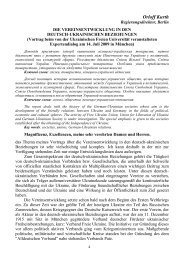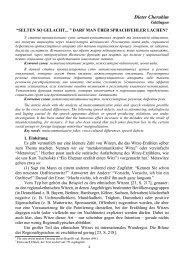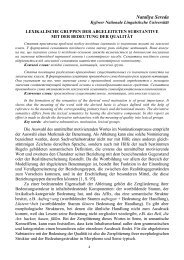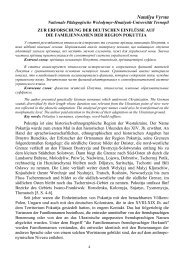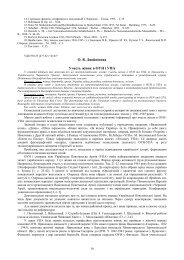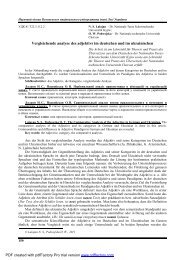влияние тяжелых металлов на состояние пигментов в ...
влияние тяжелых металлов на состояние пигментов в ...
влияние тяжелых металлов на состояние пигментов в ...
You also want an ePaper? Increase the reach of your titles
YUMPU automatically turns print PDFs into web optimized ePapers that Google loves.
180<br />
ЛІТЕРАТУРА<br />
1. Амо<strong>на</strong>ш<strong>в</strong>или Ш. А. Психологические осно<strong>в</strong>ы педагогики сотрудничест<strong>в</strong>а: Кн. для учителя /<br />
Ш.А. Амо<strong>на</strong>ш<strong>в</strong>или. - Кие<strong>в</strong> : Ос<strong>в</strong>ита, 1991. - 110,[1] с.: ил.<br />
2. Вергасо<strong>в</strong> В. М. Акти<strong>в</strong>изация поз<strong>на</strong><strong>в</strong>ательной деятельности студенто<strong>в</strong> <strong>в</strong> <strong>в</strong>ысшей школе /<br />
В.М. Вергасо<strong>в</strong>. - 2-е изд., доп. и перераб. - Кие<strong>в</strong> : Вища шк., 1985. - 174,[1] с.: ил.<br />
3. Гомеле<strong>в</strong>а О. В. Межпредметные с<strong>в</strong>язи <strong>в</strong> формиро<strong>в</strong>ании коммуникати<strong>в</strong>ных умений/ О.В.Гомеле<strong>в</strong>а //<br />
Иностранный язык <strong>в</strong> школе. – 1987. - №6. – С.71-73.<br />
4. Гершунский Б. С. Педагогическая прогностика: методология, теория, практика / Б. С. Гершунский.<br />
- Кие<strong>в</strong> : Вища шк. : Изд-<strong>в</strong>о при Кие<strong>в</strong>. гос. ун-те, 1986. - 197, [3] с.<br />
5. Ушинский К. Д. Избранные педагогические сочинения/ К.Д.Ушинский – М.:Прос<strong>в</strong>ещение,1968. -<br />
557 с.<br />
УДК 78.07:61<br />
OUTCOMES AND MICROPROCESSES IN MUSIC THERAPY<br />
Wosch Thomas, Professor Dr.<br />
University of applied sciences of Wuerzburg and Schweinfurt / Germany [EU]<br />
Within the last ten years music therapy research was growing immense. Especially outcome research<br />
developed very fast and could fullfil the world leading evidence based medicine criteria of the Cochrane-<br />
Review. Some little examples of it will be presented beside some more detailed outcomes of Wosch and<br />
Roehrborn аbout their clinical study of 1160 in-patients over seven years in psychotherapy. How does work<br />
music therapy, which items of effect it has, will be brief presented in examples of Microanalysis-Research of<br />
Wosch.<br />
Key words: music therapy, research, psychotherapy, Microanalysis-Research.<br />
Вош Томас РЕЗУЛЬТАТИ ТА МІКРОПРОЦЕСИ В МУЗИКОТЕРАПІЇ / Уні<strong>в</strong>ерситет прикладних <strong>на</strong>ук<br />
Вюрцбурга та Ш<strong>в</strong>айнфурта. Німеччи<strong>на</strong> [ЄС].<br />
За останні десять рокі<strong>в</strong> збільшилась кількість досліджень з музичної терапії. Особли<strong>в</strong>о ш<strong>в</strong>идко<br />
роз<strong>в</strong>и<strong>в</strong>алися дослідження, спрямо<strong>в</strong>ані <strong>на</strong> <strong>в</strong>ия<strong>в</strong>лення результати<strong>в</strong>ності музичної терапії. Це доз<strong>в</strong>олило<br />
музичній терапії <strong>в</strong>ико<strong>на</strong>ти критерії <strong>в</strong>сес<strong>в</strong>ітньо <strong>в</strong>ідомих огляді<strong>в</strong> Кохра<strong>на</strong>. Декілька не<strong>в</strong>еликих прикладі<strong>в</strong><br />
даного <strong>в</strong>иду досліджень, а також декілька більш детальних прикладі<strong>в</strong> з дослідження, про<strong>в</strong>еденого<br />
а<strong>в</strong>тором <strong>в</strong>продо<strong>в</strong>ж семи рокі<strong>в</strong> із залученням 1160 пацієнті<strong>в</strong> психіатрії, <strong>на</strong><strong>в</strong>едено у статті. Як <strong>в</strong>пли<strong>в</strong>ає<br />
музич<strong>на</strong> терапія? Які ефекти музичної терапії? Ці питання будуть також розроблені <strong>на</strong> прикладах<br />
мікроа<strong>на</strong>літичного дослідження Воша.<br />
Ключо<strong>в</strong>і сло<strong>в</strong>а: музикотерапія, дослідження, психіатрія, мікроа<strong>на</strong>літичне дослідження.<br />
Вош Томас РЕЗУЛЬТАТЫ И МИКРОПРОЦЕССЫ В МУЗЫКОТЕРАПИИ / Уни<strong>в</strong>ерситет прикладных<br />
<strong>на</strong>ук Вюрцбурга и Ш<strong>в</strong>айнфурта. Германия [ЕС].<br />
В течение последних десяти лет у<strong>в</strong>еличилось количест<strong>в</strong>о исследо<strong>в</strong>аний по музыкотерапии. Особенно<br />
быстро раз<strong>в</strong>и<strong>в</strong>ались исследо<strong>в</strong>ания, <strong>на</strong>пра<strong>в</strong>ленные <strong>на</strong> <strong>в</strong>ыя<strong>в</strong>ление результати<strong>в</strong>ности музыкотерапии. Это<br />
поз<strong>в</strong>олило музыкотерапии <strong>в</strong>ыполнить критерии <strong>в</strong>семирно из<strong>в</strong>естных обозрений Кохра<strong>на</strong>. Несколько<br />
небольших примеро<strong>в</strong> данного <strong>в</strong>ида исследо<strong>в</strong>аний, а также несколько более детальных примеро<strong>в</strong> из<br />
исследо<strong>в</strong>ания, про<strong>в</strong>еденного а<strong>в</strong>тором <strong>в</strong> течение семи лет с при<strong>в</strong>лечением 1160 пациенто<strong>в</strong> психиатрии,<br />
предста<strong>в</strong>лены <strong>в</strong> статье. Как <strong>в</strong>оздейст<strong>в</strong>ует музыкотерапия? Како<strong>в</strong>ы эффекты музыкальной терапии?<br />
Эти <strong>в</strong>опросы будут коротко рассмотрены <strong>на</strong> примерах микроа<strong>на</strong>литического исследо<strong>в</strong>ания Воша.<br />
Ключе<strong>в</strong>ые сло<strong>в</strong>а: музыкотерапия, исследо<strong>в</strong>ание, психиатрия, микроа<strong>на</strong>литическое исследо<strong>в</strong>ание.<br />
This article will give a brief overview and short examples of current music therapy effect research around the<br />
world and of microanalysis in music therapy. With these two focuses the article touches the horizontal level of<br />
the state of the art of outcome research in music therapy and at the same time also in the vertical level very<br />
detailed issues of very small changes which happen in and through music therapy. With these points hopefully<br />
also a brief overview of West European, North American and Down Under music therapy of the year of 2008<br />
can be given.<br />
The article is divided into three parts. The first part is the brief overview of effect research in music therapy<br />
including their success in social services and health care systems. The second part will introduce into some<br />
Педагогічні <strong>на</strong>уки
details of one outcome research in clinical practice of music therapy in psychosomatics. The third and last part<br />
will be an example of what happens in music therapy, which can be observed in microanalysis.<br />
For a long time between 1920 and the mid of the 1990-ies music therapy had no outcome research, which was<br />
accepted in the standards of psychotherapy effect research. In 1977 wrote i.e. the two Germans Strobel and<br />
Huppmann, that music therapy needs scientific proofs of its effects [17]. Even in 1994 the Swiss scientist Grawe<br />
and his team could not find acceptable studies for their meta-analysis of effects in psychotherapy [5]. However,<br />
in 2008 we reached the shift. In this year we have about seven Chochrane Reviews for the treatment of special<br />
disorders with music therapy. The Chochrane Review is the highest international evaluation of psyche therapies<br />
based on the evidence based medicine level one. Here we can find positive reviews of music therapy in the cases<br />
of autism, schizophrenia, pain treatment and others. Due to this i.e. in Germany these treatments with music<br />
therapy are included into the official medical list of indications OPS since 2006. This success has to be continued<br />
within the next years for other disorders and for other fields of practice of music therapy such as social services<br />
and education. One example for the positive reviews is the Chochrane Review of Gold and colleagues of music<br />
therapy in the treatment of schizophrenia [4].<br />
Four of 31 studies in this field between 1994 and 2004 could be included in the Chochrane Review for music<br />
therapy in the treatment of people suffering from schizophrenia in an acute phase. The four studies counted<br />
between 37 and 81 in-patients each. The main outcomes of these investigated music therapies were significant<br />
effects related to control groups in the reduction of the negative symptoms of schizophrenia. This means, that the<br />
affect was not to much or to less aroused, that social interest of the in-patients could be successfully increased<br />
and that they also could become motivated in the course of music therapy. For these effects were necessary in<br />
minimum 20 sessions of music therapy. The weakness of all four studies was, that there were no follow up<br />
groups to check also the long term effects of music therapy.<br />
Such investigations of long term effects can offer in 2008 the first results of our study ―Alex‖, which we did in<br />
Germany. This is not a study in the evidence based medicine level one. It is a research in clinical practice on the<br />
level two. However, it can give first tendencies of long term effects of music therapy related to other<br />
psychotherapies.<br />
From 2002 to 2008 1160 in-patients in a German clinic of psychotherapy and psychosomatics took place in this<br />
study (Clinics Erlabrunn gGmbH in Saxony / Germany). In the naturalistic setting of this clinic could be<br />
differentiated six different approaches of treatment. Three of these six approaches focused or included music<br />
therapy. Three others were focused in different approaches of verbal psychotherapy. The three approaches<br />
focused in music therapy or including music therapy are a group music therapy with Regulative Music Therapy<br />
[13], individual verbal psychotherapy including active group music therapy [12], [3], [15] and individual verbal<br />
psychotherapy including individual Regulative Music Therapy [11]. Regulative Music Therapy is a method of<br />
music therapy working with listening of music in a very special and high systematized therapeutic process.<br />
Active music therapy contains different approaches of music making of the client working with clinical<br />
improvisation, dancing, music and movement and elementary painting with music. One example for the weekly<br />
schedule of one of the three approaches is the group music therapy with Regulative Music Therapy. Weekly this<br />
group has 12.5 hours of music therapy (which seems to be the highest amount of weekly hours of music therapy<br />
treatment worldwide) and beside music therapy 6 hours of relaxation training (i.e. Autogenic Training), 4.5<br />
hours of sport activities (i.e. walking), 3.5 hours of art therapy, 3 hours of verbal group psychotherapy and 2.5<br />
hours of psychotherapeutic physiotherapy. From this example it becomes clear that music therapy is not the only<br />
one treatment of this group. However, in the weekly hours and in the focus of the treatment of the medical<br />
doctors, psychologists and special therapist music therapy is here the main approach of this treatment. The other<br />
three approaches which are focused in verbal psychotherapy are a psychodynamic group (Intended Dynamic<br />
Group, Höck 1976), an individual verbal psychotherapy with integrated training of perception and an individual<br />
verbal psychotherapy using different approaches of verbal psychotherapy such as psychoanalytical and<br />
behaviouristic approaches. All 1160 in-patients in the six approaches of treatment give pre-post-feedback with<br />
the questionnaires Symptom-Check-List 90 R (SCL 90 R, Franke 1995) and Toronto-Alexithymia-Scale 26<br />
(TAS 26) [8]. Alexithymia is the disorder of perception of emotion. In the follow-up-test of our study took part<br />
140 patients.<br />
These first follow-up-results were very surprising for us. These results came from the comparison of the group<br />
with Regulative Music Therapy and the psychodynamic group. The main results were that the music therapy<br />
group could reach even in the long term effect after six months after the in-patient-treatment better significances<br />
in the treatment of neurotic disorders and of the psyche symptoms of the comprehensive-compulsive symptom,<br />
of somatization and of anxiety. However, the psychodynamic group without a focus in music therapy could<br />
reach better significances in the treatment of the depressive symptom and in the identification of emotions and in<br />
the describing of emotions. From our point of view especially the treatment of disorders of perception of<br />
emotion (alexithymia) seems to be a speciality of music therapy. But the results of the follow-up-groups open a<br />
tendency for the special method of Regulative Music Therapy in the better treatment of ―cognitive‖ focused<br />
181<br />
Вісник Запорізького <strong>на</strong>ціо<strong>на</strong>льного уні<strong>в</strong>ерситету №1, 2009
182<br />
disorders and psyche symptoms. The perception of emotion was from the point of the view of the long term<br />
effect better treated in the psychodynamic approach.<br />
Moreover, in the pre-post-results of our study we find very strong arguments for individual psychotherapy<br />
including also active group music therapy. The highest significances could be reached with this approach in the<br />
treatment of the total number of all in-patients, in the treatment of affective disorders (i.e. depression), of<br />
neurotic disorders, in the treatment of highly pathological values in the psyche symptoms of depressive<br />
symptom, of comprehensive-compulsive symptom, of somatization and of anxiety. In the treatment of eating<br />
disorders (i.e. anorexia and bulimia) and of borderline disorder (a special kind of personality disorder, which<br />
becomes larger and larger in West Europe) individual psychotherapy including individual Regulative Music<br />
Therapy reached highest significances in our study.<br />
With these results in the context of our clinical practice study ―Alex‖ first long term effects in the reduction of<br />
psyche symptoms such as the comprehensive-compulsive symptom and anxiety can be seen. One method<br />
working with listening of music (Regulative Music Therapy) can offer best short term result in the treatment of<br />
eating and borderline disorders, which are very ―low success‖ disorders in other contexts of treatment. The<br />
highest potentials of treatment for a plenty of other disorders and psyche symptoms had in our study individual<br />
verbal psychotherapy including active group music therapy. Very high pathological values could be treated here<br />
with best results.<br />
To understand how music therapy works and can reach in a special way these results we will give last not least<br />
one example of a microprocess in music therapy. In this example was investigated one session of music therapy<br />
with the microanalysis TAMP (Text Analysis Method of Micro Processes) [9]. In this case a female in-patient<br />
was treated in a German clinic of psychotherapy and psychosomatics who suffered from eating disorder and<br />
personality disorder. The in-patient-treatment went over 12 weeks. Two times a week individual active music<br />
therapy took place of about 30 minutes each. The kernel of this treatment was psychoanalytically based and done<br />
with clinical improvisation of client and therapist. Also lots of other therapies took place, i.e. individual verbal<br />
psychotherapy and verbal group psychotherapy also based in a psychoanalytical approach. The example here is<br />
the 12 th session of the individual active music therapy.<br />
With TAMP this session 12 was analysed. For this we needed the audio tape of this session. We could transcribe<br />
all the talks of the client before and after the clinical improvisation. The music was evaluated with a special<br />
instruction by 40 listeners. With this we could get also 40 texts about the clinical improvisation. All detailed<br />
steps of this microanalysis you can read in Ortlieb, [14]. One short story about the process of this microanalysis<br />
is that from all texts were done qualitative text analysis with steps of TAMP. With these we got 19 categories or<br />
motifs about which were all the talks of the client before and after the clinical improvisation in this session 12<br />
and also all texts of the 40 evaluators of the clinical improvisation of the client and the therapist [19]. We could<br />
order these 19 categories in a quality 1 and a quality 2. Quality 1 means that there was the speech about stories<br />
etc. which not touches the client or the evaluator directly. Quality 2 means, that the client or the evaluator is<br />
touched by emotions or speak about him or her self. In the end we could find following results about the course<br />
of the categories in the course of this music therapy session 12. 11 times the category ―time‖ occurs in the speech<br />
of the client in the beginning of this music therapy session. This was the most mentioned category of the client in<br />
the first part of this music therapy session. This category appears in quality 1. The client spoke about the clinic,<br />
about other people, etc. Only one time the client spoke about the theme of ―time‖ in quality 2, which touches<br />
directly her self. In the music the most mentioned category of the evaluators was the category of ―rivalry‖.<br />
Evaluators did this 36 times in quality 1 and 19 times in quality 2. With this they seem to characterize in quality<br />
1 the kernel of the music (and not of their personal experience of this clinical improvisation in quality 1 in the<br />
majority). After the clinical improvisation the client not at all spoke about the theme of ―time‖ again. Most of all<br />
(11 times in quality 2 and 5 times in quality 1) she spoke now in the category of ―rivalry‖. With these results a<br />
proof of starting a new perspective or theme IN clinical improvisation is given. It also shows that in the course of<br />
one music therapy session becoming being touched is one outcome of the psyche process which takes place in<br />
the relation between client, music and therapist in individual active music therapy. The theme of ―rivalry‖<br />
became important from music therapy also to the other verbal individual psychotherapy and verbal group<br />
psychotherapy. It starts a point of change for the attitudes, emotional experience and behavior of the client [19].<br />
However, in the above mentioned numbers it is to be seen, that also after the clinical improvisation the category<br />
―rivalry‖ occurred by the client in quality 2 (mainly) AND quality 1 (in a minor but existing value). This could<br />
be seen as a special moment of effectiveness and potential of music therapy. Being touched by something AND<br />
becoming also distant to it can be one special moment of this effectiveness. This correlates to the latest results of<br />
the special items of musical experience in psychology of music and psychotherapy, were the speech is about a<br />
―neurowissenschaftliche … Sublimierung‖ [neurological scientific … sublimation] [6], [1] as the very special<br />
potential of the musical experience in psychotherapy. In this sense the musical experience in music therapy could<br />
be also named as a substitute experience. This can be a special potential i.e. for the fields of clinical practice in<br />
psychiatry, psychotherapy, and dementia care. Other fields of music therapy, which take place in ―real contexts‖<br />
of social musical life [16], work very probably with other items of the musical experience. However, in very<br />
strong crises and strong stages of helplessness of human beings a ―pre step‖ of experience is also a ―real‖<br />
Педагогічні <strong>на</strong>уки
experience, which can start to change individual experiences into a way of increasing self confidence and<br />
satisfaction.<br />
REFERENCES<br />
1. Blood, A.J. & Zatorre, R.J. (2001). Intensely pleasurable responses to music correlate with activity in brain<br />
regions implicated in reward and emotion. Proceedings of National Academy of Sciences of the United<br />
States of America, 98, 11818-11823.<br />
2. Franke, G.H. (1995). SCL-90-R - Die Symptom-Checklist von L.R. Derogatis. Göttingen: Hogrefe.<br />
3. Frohne-Hagemann, I. (2001). Musiktherapie vor dem Hintergrund integrativer Theorie und Therapie. In:<br />
Decker-Voigt, H.-H. (ed.). Schulen der Musiktherapie. München: Ernst Reinhardt Verlag, 159-182.<br />
4. Gold, C. & Heldal, T.O. & Dahle, T. & Wigram, T. (2005). Music Therapy for schizophrenia or<br />
schizophrenia-like illnesses. The Cochrane Database of Systematic Reviews 2005, Issue 2.<br />
5. Grawe, K. & Donati, R. & Bernauer, F. (1994). Psychotherapie im Wandel - Von der Konfession zur<br />
Profession. Göttingen: Hogrefe.<br />
6. Grawe, K. (2004). Neuropsychotherapie. Göttingen: Hogrefe.<br />
7. Höck, K. (1976) (ed.). Gruppenpsychotherapie. Berlin: Deutscher Verlag für Wissenschaften.<br />
8. Kupfer, J. & Brosig, B. & Brähler, E. (2001). Toronto-Alexithymie-Skala-26. Göttingen: Hogrefe.<br />
9. Ortlieb, K. & Sembdner, M. & Wosch, T. & Frommer, J. (2007). Text Analysis Method for Micro Processes<br />
(TAMP) of Single Music Therapy Sessions. In: Wosch, T. & Wigram, T. (eds.). Microanalysis in Music<br />
Therapy - Methods, Techniques and Applications for Clinicians, Researchers, Educators and Students.<br />
London & Philadelphia: Jessica Kingsley Publishers, 285-297.<br />
10. Priestley, M. (1994). Essays on Analytical Music Therapy. Phoenixville: Barcelona Publishers.<br />
11. Röhrborn, H. (2007). Dyadic Regulative Music Therapy - Experiences from a Psychotherapy Ward of a<br />
Hospital. In: Frohne-Hagemann, I. (ed.). Receptive Music Therapy - Theory and Practice. Wiesbaden:<br />
Reichert Verlag, 211-222.<br />
12. Schwabe, C. (1997). Aktive Musiktherapie für erwachsene Patienten. Weida: Akademie für angewandte<br />
Musiktherapie Crossen.<br />
13. Schwabe, C. & Röhrborn, H. (1996) (eds.). Regulative Musiktherapie - Entwicklung, Stand und<br />
Perspektiven in der psychotherapeutischen Medizin. Jena & Stuttgart: Gustav Fischer Verlag.<br />
14. Sembdner, M. & Wosch, T. & Frommer, J. (2004). Musiktherapeutische Einzelfallforschung -<br />
Sprachanalytische Prozessuntersuchung zu einer musiktherapeutischen Improvisation. Musiktherapeutische<br />
Umschau, 25 (2), 154-163.<br />
15. Smeijsters, H. (1995). Handboek muziektherapie. Theoretische en methodische grondslagen voor de<br />
behandeling van specifieke stoornissen en handicaps. Heerlen: Melos.<br />
16. Stige, B. (2003). Elaborations toward a notion of community music therapy. Oslo: Unipub forlag.<br />
17. Strobel, W. & Huppmann, G. (1977). Musiktherapie - Grundlagen, Formen, Möglichkeiten. Göttingen:<br />
Hogrefe.<br />
18. Wosch, T. (2002). Emotionale Mikroprozesse musikalischer Interaktionen - Eine Einzelfallanalyse zur<br />
Untersuchung musiktherapeutischer Improvisationen. Münster: Waxmann.<br />
19. Wosch, T. & Frommer, J. & Gastmann, C. & Sembdner, M. (2001). Zwei Ansätze - ein Verlauf - Belege<br />
integrativen Arbeitens anhand eines Einzelfallbeispiels der Psychotherapie. Musiktherapeutische Umschau,<br />
22 (1), 19-30.<br />
20. See also www.voices.no<br />
21. Thomas Wosch, Prof. Dr., University of applied sciences of Würzburg and Schweinfurt / Germany,<br />
wosch@fh-wuerzburg.de<br />
183<br />
Вісник Запорізького <strong>на</strong>ціо<strong>на</strong>льного уні<strong>в</strong>ерситету №1, 2009





